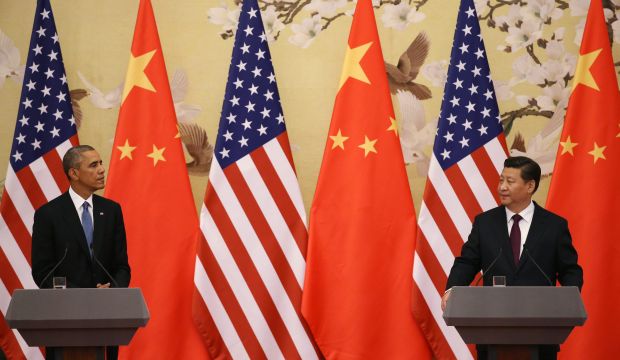
US President Barack Obama (L) and Chinese President Xi Jinping attend a press conference at the Great Hall of the People, in Beijing, China, on November 12, 2014. (EPA/How Hwee Young)
Beijing, Reuters—China and the United States agreed on Wednesday to new limits on carbon emissions starting in 2025, but the pledge by the world’s two biggest polluters appears to be more politically significant than substantive.
As China’s President Xi Jinping agreed to a date for peak CO2 emissions for the first time and also promised to raise the share of zero-carbon energy to 20 percent of the country’s total, President Barack Obama said the United States would cut its own emissions by more than a quarter by 2025.
At its best, the announcement threw the political weight of the world’s two biggest economies behind a new global climate pact to be negotiated in Paris next year.
But the United States has already pledged to cut its carbon emissions by 17 percent by 2020 and it is not clear if the new proposals will pass a Republican-dominated Congress.
In a statement, Senate Republican Leader Mitch McConnell branded the new US emission cuts as part of Obama’s “ideological war on coal,” and said his priority in the new Congress was “easing the burden” of environmental regulations.
With China still falling short of any absolute target to reduce emissions, Obama could face even more pressure.
For China, the targets add little to its existing commitments to wean itself off carbon, environmental experts said.
“The statement is a upbeat signal to motivate other countries but the timeline China has committed to is not a binding target,” said Li Junfeng, an influential Chinese climate policy adviser linked to China’s state planning agency, the National Development and Reform Commission.
The peak date was also in line with forecasts already made by several state-backed think-tanks, with the China Academy of Social Sciences saying in a study last week that slowing rates of urbanization would likely mean that industrial emissions would peak around 2025–2030 and start to fall by 2040.
US officials said the commitments, the result of months of dialogue between the two countries, would spur other nations to make pledges and deliver “a shot of momentum” into negotiations for the new global agreement.
“Today’s announcement is the political breakthrough we’ve been waiting for,” said Timothy E. Wirth, former US undersecretary of state for global affairs and the vice chairman of the United Nations Foundation.
“If the two biggest players on climate are able to get together, from two very different perspectives, the rest of the world can see that it’s possible to make real progress,” he said in a statement.
The targets could have been more far-reaching, environmental experts said.
“It is a very good sign for both countries and injects strong momentum [into negotiations], but the targets are not ambitious enough,” said Tao Wang, climate scholar at the Tsinghua–Carnegie Center for Global Policy in Beijing.
China’s targets should serve as “the floor and not the ceiling”, said Li Shuo, a campaigner with environmental group Greenpeace in Beijing. He said the vague wording of “around 2030” also did not help, and could mean any time between 2027 and 2033.
China also pledged to boost the share of non-fossil fuels in its energy mix to around 20 percent by 2030, from less than 10 percent in 2013, a move that could require 1,000 gigawatts of new nuclear and renewable capacity, but Wang said the figure took China little further than “business as usual.”
“That figure isn’t high, because China aims to reach about 15 percent by 2020, so it is only a five percentage point increase in 10 years, and given the huge growth in renewables, it should be higher,” he said.
Li, the climate policy adviser, said Beijing was not expected to make any significant new commitments next year, adding that it would also be wise not to expect too much of the United States.
China will not look to America to take action against climate change, he said. “It is in our own interest to promote clean energy, restructure our model of economic growth and cleaning air pollution.”
